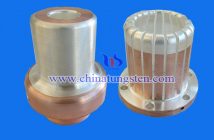Based on conventional molding process and combines plastic molding industry technology, PIM (Powder Injection Molding) has excellent applicability in some tungsten copper products with small size and complex shape or structure. So we study from mixing, injection, degreasing, sintering and several key process of tungsten copper powder injection molding, and analyze and summarize the advantages of the process and the defects.
The first is the selection of the binder and the preparation of mixture. Binders can reduce caking of the powder, which has good flowability, and plays the role of maintaining the shape of the body until degreasing sintering. Thus the choice of the binder is injection molded in a key ring, it should meet the deformation and cracking does not occur before the product sintering defect, and easy to be removed. Now more use thermoplastic or some polymers as binders, such as paraffin, stearic acid, HDPE, EVA and so on. In the process of mixing, paraffin and stearic acid are liquid phase, which does not destroy the nature of the binder. In addition, wherein the order of addition of powder and a binder is the final state of the blank has a certain influence. The next is granulating, and select particles about 2-3mm for injection molding.
Since the injection process to fill the cavity is more complex, many parameters must be well controlled, once appear unreasonable control can cause a variety of defects. We introduce some common defects and the corresponding solutions: 1. Under-injection, it refers to the injection process feed can not fill the mold cavity, the corresponding solution is three-pronged approach from the injection temperature, feeding quantity and viscosity of the feed itself causes analyzed; 2. The pores, it is the most common type of defect, the corresponding method is to pay attention to whether the injection and mixing of air entrainment and make adjustments, check the injection speed, the injection pressure, etc; 3. Unstable quality, it should be considered that whether the powder is uniform and the segregation with the binder.




